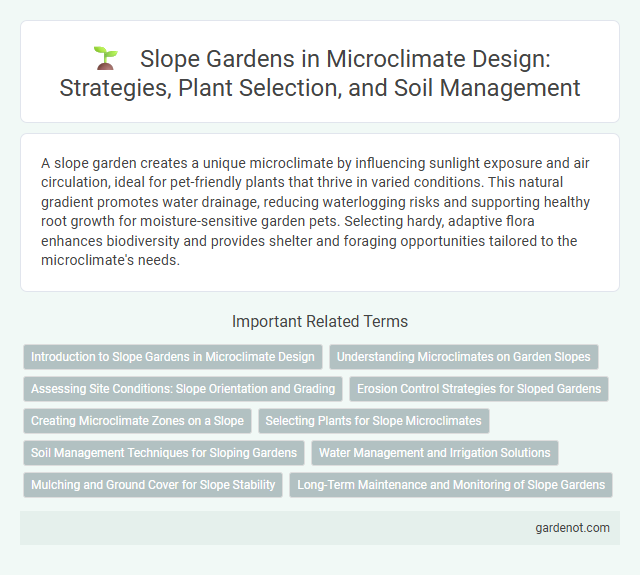A slope garden creates a unique microclimate by influencing sunlight exposure and air circulation, ideal for pet-friendly plants that thrive in varied conditions. This natural gradient promotes water drainage, reducing waterlogging risks and supporting healthy root growth for moisture-sensitive garden pets. Selecting hardy, adaptive flora enhances biodiversity and provides shelter and foraging opportunities tailored to the microclimate's needs.
Introduction to Slope Gardens in Microclimate Design
Slope gardens play a crucial role in microclimate design by optimizing natural water drainage and sunlight exposure on inclined terrains. These gardens use terracing and plant selection to reduce soil erosion, improve air circulation, and create varied microhabitats that support biodiversity. Effective slope garden design enhances temperature regulation and moisture retention, contributing to a balanced and sustainable microclimate environment.
Understanding Microclimates on Garden Slopes
Garden slopes create diverse microclimates due to variations in sun exposure, wind patterns, and soil drainage, influencing plant growth and survival. South-facing slopes typically receive more sunlight and warmth, favoring heat-loving plants, while north-facing slopes remain cooler and moist, supporting shade-tolerant species. Understanding these microclimate differences allows gardeners to strategically select and position plants for optimal growth and ecosystem balance on sloped terrain.
Assessing Site Conditions: Slope Orientation and Grading
Assessing site conditions in a slope garden requires detailed analysis of slope orientation and grading to optimize plant growth and water drainage. South-facing slopes in the northern hemisphere typically receive more sunlight, favoring drought-tolerant species, while north-facing slopes retain moisture and support shade-loving plants. Proper grading prevents soil erosion and facilitates efficient runoff management, critical for sustaining a healthy microclimate garden ecosystem.
Erosion Control Strategies for Sloped Gardens
Erosion control strategies for sloped gardens involve using deep-rooted plants, terracing, and ground covers to stabilize soil and prevent runoff. Installing retaining walls or contour planting guides water flow and reduces soil displacement. Mulching and drip irrigation systems minimize soil erosion by maintaining moisture and protecting the garden's microclimate.
Creating Microclimate Zones on a Slope
Creating microclimate zones on a slope garden involves strategically positioning plants and structures to optimize sunlight exposure, wind protection, and moisture retention. Terracing or contouring the slope aids in reducing soil erosion and enhances water infiltration, promoting diverse microhabitats. Selecting drought-tolerant species for upper zones and moisture-loving plants for lower areas maximizes ecological balance and plant health.
Selecting Plants for Slope Microclimates
Selecting plants for slope microclimates requires choosing species that tolerate varying moisture levels and soil erosion. Deep-rooted groundcovers like creeping juniper and sedum stabilize the soil and reduce runoff on steep inclines. Native drought-resistant shrubs and perennials also thrive in well-drained, sun-exposed slopes, promoting sustainable growth and minimizing maintenance.
Soil Management Techniques for Sloping Gardens
Effective soil management in slope gardens involves implementing erosion control methods such as terracing, contour planting, and the use of mulch or ground cover to stabilize the soil structure. Incorporating organic matter like compost improves water retention and nutrient availability on inclined surfaces, reducing runoff and enhancing plant health. Employing deep-rooted plants further binds the soil, preventing landslides and promoting sustainable microclimate conditions in garden slopes.
Water Management and Irrigation Solutions
Slope gardens require effective water management techniques to prevent soil erosion and optimize moisture retention. Implementing terracing, drip irrigation systems, and rainwater harvesting enhances water efficiency while supporting plant health on inclined surfaces. These solutions balance irrigation needs with natural rainfall, promoting sustainable microclimate conditions.
Mulching and Ground Cover for Slope Stability
Mulching and ground cover play crucial roles in maintaining slope stability within microclimate gardens by reducing soil erosion and moisture loss. Organic mulches like wood chips and straw help retain soil moisture, regulate temperature, and encourage beneficial microbial activity, promoting plant root growth. Dense ground covers such as creeping thyme or native grasses anchor the soil, prevent surface runoff, and improve infiltration, effectively minimizing slope degradation.
Long-Term Maintenance and Monitoring of Slope Gardens
Long-term maintenance and monitoring of slope gardens are essential for preventing soil erosion and ensuring vegetation stability. Regular inspections should focus on drainage systems, plant health, and erosion control measures to adapt to environmental changes effectively. Implementing erosion-resistant plants and reinforcing soil with organic mulches or geotextiles helps sustain slope integrity over time.
Slope garden Infographic

 gardenot.com
gardenot.com